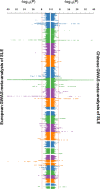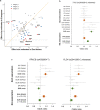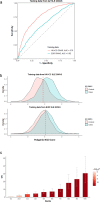Identification of 38 novel loci for systemic lupus erythematosus and genetic heterogeneity between ancestral groups
- PMID: 33536424
- PMCID: PMC7858632
- DOI: 10.1038/s41467-021-21049-y
Identification of 38 novel loci for systemic lupus erythematosus and genetic heterogeneity between ancestral groups
Abstract
Systemic lupus erythematosus (SLE), a worldwide autoimmune disease with high heritability, shows differences in prevalence, severity and age of onset among different ancestral groups. Previous genetic studies have focused more on European populations, which appear to be the least affected. Consequently, the genetic variations that underlie the commonalities, differences and treatment options in SLE among ancestral groups have not been well elucidated. To address this, we undertake a genome-wide association study, increasing the sample size of Chinese populations to the level of existing European studies. Thirty-eight novel SLE-associated loci and incomplete sharing of genetic architecture are identified. In addition to the human leukocyte antigen (HLA) region, nine disease loci show clear ancestral differences and implicate antibody production as a potential mechanism for differences in disease manifestation. Polygenic risk scores perform significantly better when trained on ancestry-matched data sets. These analyses help to reveal the genetic basis for disparities in SLE among ancestral groups.
Conflict of interest statement
The authors declare no competing interests.
Figures





Similar articles
-
Identification of Shared and Asian-Specific Loci for Systemic Lupus Erythematosus and Evidence for Roles of Type III Interferon Signaling and Lysosomal Function in the Disease: A Multi-Ancestral Genome-Wide Association Study.Arthritis Rheumatol. 2022 May;74(5):840-848. doi: 10.1002/art.42021. Epub 2022 Mar 29. Arthritis Rheumatol. 2022. PMID: 34783190
-
Meta-analysis of 208370 East Asians identifies 113 susceptibility loci for systemic lupus erythematosus.Ann Rheum Dis. 2021 May;80(5):632-640. doi: 10.1136/annrheumdis-2020-219209. Epub 2020 Dec 3. Ann Rheum Dis. 2021. PMID: 33272962 Free PMC article.
-
Genome-wide association meta-analysis in Chinese and European individuals identifies ten new loci associated with systemic lupus erythematosus.Nat Genet. 2016 Aug;48(8):940-946. doi: 10.1038/ng.3603. Epub 2016 Jul 11. Nat Genet. 2016. PMID: 27399966 Free PMC article.
-
Recent advances in systemic lupus erythematosus genetics in an Asian population.Int J Rheum Dis. 2015 Feb;18(2):192-9. doi: 10.1111/1756-185X.12498. Epub 2014 Dec 19. Int J Rheum Dis. 2015. PMID: 25522798 Review.
-
The genetics and molecular pathogenesis of systemic lupus erythematosus (SLE) in populations of different ancestry.Gene. 2018 Aug 20;668:59-72. doi: 10.1016/j.gene.2018.05.041. Epub 2018 May 25. Gene. 2018. PMID: 29775752 Review.
Cited by
-
Emerging concepts of type I interferons in SLE pathogenesis and therapy.Nat Rev Rheumatol. 2022 Oct;18(10):575-590. doi: 10.1038/s41584-022-00826-z. Epub 2022 Sep 12. Nat Rev Rheumatol. 2022. PMID: 36097207 Review.
-
Association between systemic lupus erythematosus and inflammatory bowel disease in European and East Asian populations: a two-sample Mendelian randomization study.Front Immunol. 2023 Nov 3;14:1199896. doi: 10.3389/fimmu.2023.1199896. eCollection 2023. Front Immunol. 2023. PMID: 38022503 Free PMC article.
-
Systemic Lupus Erythematosus and Immunodeficiency.Rheumatol Immunol Res. 2021 Dec 15;2(3):131-138. doi: 10.2478/rir-2021-0019. eCollection 2021 Sep. Rheumatol Immunol Res. 2021. PMID: 36465072 Free PMC article. Review.
-
Interpretable machine learning identifies paediatric Systemic Lupus Erythematosus subtypes based on gene expression data.Sci Rep. 2022 May 6;12(1):7433. doi: 10.1038/s41598-022-10853-1. Sci Rep. 2022. PMID: 35523803 Free PMC article.
-
Fully exploiting SNP arrays: a systematic review on the tools to extract underlying genomic structure.Brief Bioinform. 2022 Mar 10;23(2):bbac043. doi: 10.1093/bib/bbac043. Brief Bioinform. 2022. PMID: 35211719 Free PMC article.
References
-
- Lawrence JS, Martins CL, Drake GL. A family survey of lupus-erythematosus .1. heritability. J. Rheumatol. 1987;14:913–921. - PubMed
Publication types
MeSH terms
LinkOut - more resources
Full Text Sources
Other Literature Sources
Medical
Research Materials

